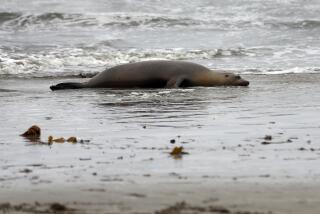Anglers Sink Teeth Into Wild Barracuda Bite
Took the boat out last Friday to conduct some field research--basically to check out reports that thousands of marauding barracuda were turning Santa Monica Bay upside down.
We stopped first at the King Harbor fuel dock to top off the tanks and found the facility closed, with the figurative “Gone Fishing” sign in the window.
Next stop, the bait receiver, which also was closed, which came as no surprise because the Redondo Beach bait operation in recent weeks has been about as reliable as, well, the fuel dock.
“You won’t even need bait,” another fisherman yelled as he piloted his vessel toward the mouth of the harbor.
Turned out, he was right.
The scene outside the harbor was wild.
Dozens of fishing boats--including party boats from as far as Newport Beach--had joined in the spectacle.
Gulls were soaring over the hot spots, swooping down after anchovies and sardines. Pelicans had become dive bombers: One by one they folded their wings and dropped from the sky, plunging in head first and emerging with beaks bulging with baitfish.
These small fish, which had enjoyed a bay relatively free of predators for several weeks, were being corralled into “meatballs” at the surface and ripped apart by their attackers.
So voracious were the swift and slender barracuda that they were lashing out after anything remotely resembling a fish.
Their frantic pursuit had become a game of Russian roulette. They would either sink their teeth into flesh or strike iron and find themselves forced into a fight for survival.
Even the fishermen seemed in a frenzy. They whooped it up while bouncing barracuda onto the decks of their vessels and casting out for more.
Ten-fish limits were the rule, and the fish were unusually large, measuring nearly four feet and weighing 10 pounds or more.
So ridiculous was the bite that the three fishermen on our small boat caught and released more than 100 barracuda, and because we weren’t using any barbs on our lures--to minimize damage to their fragile mouths--we lost nearly as many.
One landing operator called it “the bite of a lifetime.”
Ricky Carbajal, skipper of the New Del Mar out of Marina del Rey, said he had never seen anything like what transpired in the bay last Thursday and Friday. His tally for Friday: 690 barracuda for 69 people. His score the day before: 730 barracuda for 73 people.
“There were fish all the way from the tankers [near LAX] to Point Vicente [on the Palos Verdes Peninsula],” he said. “The only reason I went this far south is so we’d have enough time to clean our fish on the way home.”
After a comparatively slow week, they were at it again Thursday as a slightly smaller class of barracuda launched another predawn invasion to start the chaos all over again.
ALBACORE ON!
Yes, it’s early for the Southland’s most popular game fish to show locally, but they’re lurking just beyond range of the one-day fleet.
Two 20-pounders were bagged 190 miles south of San Diego last week aboard Point Loma Sportfishing’s Vagabond, which was on a multiday trip. The Vagabond was back in the same area Wednesday and reported an additional 28 albacore. The Shogun reported 17 Wednesday and was still fishing Thursday.
“That’s exactly where the first albacore showed up last year and we had a season on our hands two weeks later,” says Philip Friedman of 976-TUNA, the information hotline that monitors game fish activity off Southern California and Baja.
The Pacific Queen out of Fisherman’s Landing and Legend out of Seaforth Sportfishing are leaving tonight on 2 1/2-day exploratory trips to try to locate the fish a little closer to home.
HOT RAILS
* Santa Barbara Island and, to a lesser extent, Santa Catalina Island continue to yield good numbers of white seabass and yellowtail. Examples: The Top Gun, L.A. Harbor, 16 white seabass and 74 yellowtail for 16 anglers; the Legacy out of Redondo, 53 yellowtail and three white seabass for 15 people; the Islander out of 22nd Street in San Pedro, four consecutive days of white seabass limits at Catalina.
* Sailfish capital of the world? Texas angler T.O. McLean’s vote is for Costa Rica. He recently fished 12 days with Rick Rhulow aboard Kingfisher out of remote Playa Carrillo. He raised 204 sailfish, had 131 takers and caught and released 75. “What makes it more remarkable,” Rhulow says, “is that he’s 83 years old and fishes alone.” Rhulow can be reached via e-mail at [email protected].
* In Mazatlan, the season’s first blue marlin, an estimated 400-pounder, was caught and released by a Florida angler aboard the Aries VI. Off the coast of this mainland Mexican resort, sailfish are the most sought-after billfish, and many are being sighted but few are willing to bite. Aries’ U.S. rep is Cortez Yacht Charters in Lemon Grove near San Diego.
* In southern Baja, Jennifer Elliott of Highland reports good fishing out of San Jose del Cabo. How good: She caught 17 yellowfin tuna and a 130-pound striped marlin on Victor’s Fleet out of Palmilla Beach. Victor’s U.S. rep is Jig Stop Tours in Dana Point.
WHIRLING CONCERNS
Someone called to check on a “rumor” that the Eastern Sierra’s famous Alpers trout were affected by whirling disease, a condition that can leave young trout disoriented and deformed.
It’s no rumor. Evidence of whirling disease has been found in the fish production facility of the Alpers family ranch on the Owens River, but “we do not yet see that as a threat,” said Mike Haynie, a Department of Fish and Game biologist.
Haynie said that although organisms associated with whirling disease have been detected, Alpers’ famous rainbow trout have yet to show any “physiological manifestations, such as swimming in circles.”
Said Tim Alpers: “We discovered a very low-level benign infection [in the water], but not the disease. There has been no outward manifestation whatsoever and this is a non-problematic issue. My fish are fine, they’re beautiful and we’re ready for another good season.”
As a safeguard, however, Alpers will not be permitted to plant fish in any new waters this season: only those he has historically stocked.
The DFG’s Mt. Whitney hatchery also is affected by whirling disease and the historic facility is being used solely for egg production, “and all of the eggs are disinfected before they’re sent to other facilities,” Haynie said.
WILD FILE
* Snow is melting and deer are migrating back to the high country, skirting Mammoth Lakes suburbs as they go. And lurking in the shadows, presumably, are mountain lions. At least two sightings in the Sierra Meadows area have generated concern among residents.
One man told the Mammoth Times that he encountered a large lion “crouched on a path” before him and his daughter, and three dogs, as they were hiking at dusk. He chased the lion off, but said it followed the group back to their car at a distance of about 75 feet.
DFG warden Al Zamudio said he could not confirm the presence of cougars in the area but did not doubt the reports. Hikers should be aware that deer habitat is also cougar country, he said.
* In Lake Havasu, a coyote last week bit a 4-year-old boy on the arm while he was playing in his backyard. His mother came out and shooed the animal away. A few days later, a coyote attacked a 4-year-old girl, in her backyard. She suffered puncture wounds behind the ear and a half-circle gash on her head.
An effort was launched to destroy two adult coyotes, who shared a den nearby, and test them for rabies. Arizona wildlife officials, in a sentiment shared by their California counterparts, said people should never feed wild animals and need to keep a more watchful eye on children in rural areas.
WINDING UP
Shark attacks on humans are down worldwide, but is this good news? For surfers and swimmers, yes. For sharks, maybe not.
Shark attacks in 1998 dropped from 57 to 49 and scientists are uncertain whether the primary reason is overfishing or changes in weather patterns. It’s probably a little of both.
George Burgess, director of the International Shark Attack File at the University of Florida, compiles statistics pertaining to shark attacks. A sampling:
* Surfers are most at risk, accounting for 69% of the attacks. Swimmers and divers are next at about 15% each.
* More than half of last year’s attacks (25) were in North American waters and 19 of those were in Florida, one a fatality involving a 9-year-old boy and a six-foot tiger shark.
* The big news, Burgess said, is that South Africa reported 17 attacks, more than three times its annual average.
* The bigger news, as far as Californians are concerned, is that there was only one attack off our coast, albeit a dramatic one involving a juvenile great white and bodyboarder Jonathan Kathrein of Lucas Valley, Calif., off Stinson Beach near San Francisco. Kathrein suffered serious leg injuries and the beach was closed for a week.






